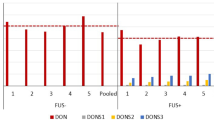Abstract
The aim of this study was to examine the effects of a control diet (CON, 0.25 mg DON/kg diet) or a Fusarium toxin-contaminated diet (FUS, 4.49 mg DON/kg diet) without and with humic substances (HS) (CON-HS and FUS-HS, 0.23 and 4.56 mg DON/kg diet, respectively) on piglets during a 5-week growth trial starting after weaning (6.7 ± 0.9 kg live weight, n = 20/group). Feed intake was significantly reduced by feeding the FUS containing diets by approximately 21% compared with the CON diet irrespective of HS supplementation. The decrease in live weight gain paralleled the feed intake depression and amounted to approximately 26%. Feeding the FUS diet was clearly reflected by the DON levels in blood. While only traces of DON with median concentrations of 3 ng/ml (2–5 ng/ml) and 2 ng/ml (0–3 ng/ml) were detected in piglets fed the CON and CON-HS diets, respectively, significantly higher levels of 22.5 ng/ml (7–30 ng/ml) and 23.5 ng/ml (15–32 ng/ml) were found in piglets fed the FUS and FUS-HS diet, respectively. The urinary excretion of DON and its metabolite de-epoxy-DON as percentage of DON intake was not significantly influenced by HS supplementation and amounted to 24.1 and 20.2% for groups FUS and FUS-HS, respectively. In conclusion, the tested HS preparation cannot be recommended as a DON inactivating feed supplement for pigs.


Similar content being viewed by others
References
Dänicke S, Döll S, Goyarts T, Seeling K, Valenta H, Ueberschär K-H (2008) Metabolism, kinetics and occurence of deoxynivalenol (DON) and zearalenone (ZON) in physiological samples of pigs, ruminants and poultry. In: Oswald IP, Taranu I (eds) Mycotoxins in farm animals. Transworld Research Network, Trivandrum, Kerala, India, pp 235–273
Dänicke S, Brosig B, Klunker LR, Kahlert S, Kluess J, Döll S, Valenta H, Rothkötter HJ (2012) Systemic and local effects of the Fusarium toxin deoxynivalenol (DON) are not alleviated by dietary supplementation of humic substances (HS). Food Chem Toxicol 50:979–988
Döll S, Dänicke S (2004) In vivo detoxification of Fusarium toxins. Arch Anim Nutr 58:419–441
Döll S, Dänicke S (2011) The Fusarium toxins deoxynivalenol (DON) and zearalenone (ZON) in animal feeding. Prev Vet Med 102:132–145
Fuchs V, Kühnert M, Golbs S (1986) Detoxifizierende Wirkung von Huminsäuren gegenüber ausgewählten Schadstoffen. Mh Vet-Med 41:712-713
Gfe (2006) Ausschuss für Bedarfsnormen der Gesellschaft für Ernährungsphysiologie: Empfehlungen zur Energie- und Nährstoffversorgung von Schweinen. DLG, Frankfurt (Main)
Golbs S, Kühnert M (1983) Huminsäureanwendung in Therapie, Pro- und Metaphylaxe in der Veterinärmedizin. Z Physiother 35:151-158
Goyarts T, Dänicke S, Grove N, Tiemann U, Rothkötter H-J (2006) Methodical aspects of in vitro proliferation of porcine blood lymphocytes when exposed to deoxynivalenol (DON). Landbauforsch Völk 56:139–148
Islam KMS, Schuhmacher A, Gropp JM (2005) Humic acid substances in animal agriculture. Pak J Nutr 4:126–134
Kabak B, Dobson AD, Var I (2006) Strategies to prevent mycotoxin contamination of food and animal feed: a review. Crit Rev Food Sci Nutr 46:593–619
Karlovsky P (2011) Biological detoxification of the mycotoxin deoxynivalenol and its use in genetically engineered crops and feed additives. Appl Microbiol Biotechnol 91:491–504
Keese C, Meyer U, Valenta H, Schollenberger M, Starke A, Weber IA, Rehage J, Breves G, Dänicke S (2009) No carry over of unmetabolised deoxynivalenol in milk of dairy cows fed high concentrate proportions. Mol Nutr Food Res 52:1514–1529
Klöcking R, Helbig B (2005) Medical aspects and applications of humic substances.In: Steinbüchel A, Marchessault RH (eds) Biopolymers for Medical and Pharmaceutical Applications. Wiley-Vch, Weinheim, pp 3–15
Kraft W, Dürr UM (2005) Klinische Labordiagnostik in der Tiermedizin, 6. Aufl. Schattauer, Stuttgart New York
Kühnert M (1979) Untersuchungen über chemische Eigenschaften sowie chemisch-toxikologische Wirkungen von Huminsäuren mit der Zielstellung ihrer Anwendung in der Medizin/speziell Veterinärmedizin. Promotion B, Veterinärmedizinischen Fakultät der Universität Leipzig, Leipzig
Kühnert M, Golbs S, Fuchs V (1980) Use of humic acids in therapy and metaphylaxis of enteritis in calf. Monatsh Veterinarmed 35:144–146
Kühnert M, Fuchs V, Golbs S (1989) Pharmacologic and toxicologic properties of humic acids and their activity profile for veterinary medicine therapy. Dtsch Tierarztl Wochenschr 96:3–10
Kühnert M, Bartels KP, Kröll S, Lange N (1991) Veterinary pharmaceuticals containing humic-acid for therapy and prophylaxis for gastrointestinal-diseases of dog and cat. Monatsh Veterinarmed 46:4–8
Naumann C, Bassler R (1993) Die chemische Untersuchung von Futtermitteln. VDLUFA, Darmstadt
Oldenburg E, Bramm A, Valenta H (2007) Influence of nitrogen fertilization on deoxynivalenol contamination of winter wheat—experimental field trials and evaluation of analytical methods. Mycotoxin Res 23:7–12
Park DL (1993) Perspectives on mycotoxin decontamination procedures. Food Addit Contam 10:49–60
Pena-Méndez EM, Havel J, Patocka J (2005) Humic substances - compounds of still unknown structure: applications in agriculture, industry, environment, and biomedicine. J Appl Biomed 3:13–24
Sabater-Vilar M, Malekinejad H, Selman MH, Van Der Doelen MA, Fink-Gremmels J (2007) In vitro assessment of adsorbents aiming to prevent deoxynivalenol and zearalenone mycotoxicoses. Mycopathologia 163:81–90
Sato T, Ose Y, Nagase H, Hayase K (1987) Adsorption of mutagens by humic acid. Sci Total Environ 62:305–310
Stein K (1994) Vergleichende Untersuchungen zu ausgewählten pharmakologischen und toxikologischen Eigenschaften verschiedener Huminsäurenprodukte. Dissertation, Veterinärmedizinische Fakultät der Univ. Leipzig, Leipzig
Valenta H, Dänicke S, Döll S (2003) Analysis of deoxynivalenol and de-epoxy-deoxynivalenol in animal tissues by liquid chromatography after clean-up with an immunoaffinity column. Mycotoxin Res 19:51–55
Van Rensburg C, Van Rensburg CE, Van Ryssen JB, Casey NH, Rottinghaus GE (2006) In vitro and in vivo assessment of humic acid as an aflatoxin binder in broiler chickens. Poult Sci 85:1576–1583
Acknowledgements
The assistance of the co-workers of the Institute of Animal Nutrition, Friedrich-Loeffler-Institute Braunschweig, Germany, in performing the experiment and analyses is gratefully acknowledged.
Conflict of interest
None.
Author information
Authors and Affiliations
Corresponding author
Rights and permissions
About this article
Cite this article
Dänicke, S., Valenta, H. & Kersten, S. Humic substances failed to prevent the systemic absorption of deoxynivalenol (DON) and its adverse effects on piglets. Mycotoxin Res 28, 253–260 (2012). https://doi.org/10.1007/s12550-012-0138-7
Received:
Revised:
Accepted:
Published:
Issue Date:
DOI: https://doi.org/10.1007/s12550-012-0138-7




